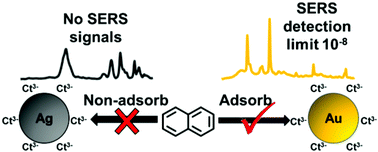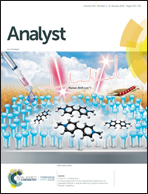Exploiting the chemical differences between Ag and Au colloids allows dramatically improved SERS detection of “non-adsorbing” molecules†
Abstract
In colloidal SERS only analytes that can spontaneously adsorb onto nanoparticles are detected. Therefore, considerable effort has been placed on modifying the surface properties of colloidal particles, particularly Ag particles, to promote the absorption of “difficult” analytes which do not spontaneously adsorb to as-prepared nanoparticles. In contrast, much less attention has been paid to the role which the identity of the underlying metal plays in the absorption since it is widely believed that the chemical properties of Ag and Au are very similar. This leads to the assumption that molecules which do not adsorb to Ag, such as hydrocarbons, will also not adsorb to aggregated Au colloids for SERS measurements. Here, we challenge this common perception by showing that SERS detection of “difficult” aromatic targets such as naphthalene, trinitrotoluene and 3,4-methylenedioxymethamphetamine which cannot be achieved even at >10−3 M concentrations with bare aggregated Ag colloids is possible at ≥10−8 M with unmodified aggregated Au colloids. For naphthalene and 3,4-methylenedioxymethamphetamine the detection limit obtained in this work with bare citrate-capped Au particles exceeds the previous best limit of detection obtained with surface-modified nanoparticles by an order of magnitude.



 Please wait while we load your content...
Please wait while we load your content...